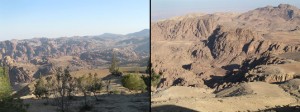
1st Nov 2012 by Hoo Ban Khee –

To set foot on Jordan is to walk on the land of the Old Testament. So when you step out of the Queen Alia International Airport in Amman after more than eight hours’ flight from Kuala Lumpur, you may have to mentally time-switch yourself in order to experience the “real world” of the ancient days of the Bible.
A large part of Deuteronomy in the Old Testament was set in Jordan where Moses and his followers trudged north for 40 years through the great wilderness with his followers after crossing the Red Sea to escape the Egyptians.
This is where Moses was shown the Promised Land by God and later was buried when he died at the age of 120. This is where Jesus was baptized by John the Baptist and began His ministry. And this is where the famous Dead Sea marks the border between Jordan and Israel.
It was after travelling up and down Jordan’s dry and thirsty desert land that one could then realize why Moses had to coax, coerce, command and scold the Jews who largely blamed him for taking them away from the so called comforts of Egypt.
The days of Moses when he crossed through the desert!

As nearly 80 per cent of Jordan is desert, referred to in the Bible as “the great wilderness”, it was a tough, tough journey to make for the Jews. Picturing the reality of it – they were not on a holiday trek; no comforts of the 4×4 of modern day. They were carrying with them their children, tents, household implements, luggage and all, not to mention the fact that they had to fight against various tribes in order to cross over to Gilgal and to begin their conquest of Canaan land.
And finally when God took Moses up to Mount Nebo and showed him the land “flowing with milk and honey”, it must have been exhilarating for him to say the least after spending his last 40 years wandering in the desert leading thousands of whining and complaining people to the very doorstep of the “land of milk and honey”.
Yet, his feelings must also have been mixed: that his work was finally over for the Lord had not allowed him to enter it due to his disobedience.

And thus in Deuteronomy 34:1 states that:
“Then Moses went up from the plains of Moab to Mount Nebo, to the top of Pisgah which is across from Jericho. And the Lord showed him all the land of Gilead as far as Dan, all Naphtali and the land of Ephraim and Manasseh, all the land of Judah as far as the Western Sea, the south and the plain of the valley of Jericho, the city of palm trees, as far as Zoar.”
Where Moses saw the land he could not cross
The job of leading the Jews into the Promised Land was left to Joshua. Moses died at the age of 120 years and the Lord buried him on Mount Nebo although the remains were never found.
Mount Nebo, which is about an hour’s drive south-west of Amman, is the most revered holy site of Jordan. It is a “must see” location especially for Christian pilgrims. Even the late Pope John Paul II would not give it a miss despite his failing health when he visited Jordan in 2000.
The drive up to Mount Nebo was a breeze nowadays. Fancy Moses climbing it at the age of 120! The path leading to the viewing point was marked with ancient relics. Atop the mountain, one could see the lush valley stretching out under the haze of the mid-day sun.
It overlooks part of the blue Dead Sea on the left, the Jordan River valley and the ancient Jericho city dotted with clusters of grayish buildings farther down on my right.
The distant hills of Israel form the hazy skyline beyond the valley and up the mountain beyond those rose-red mountains are Bethlehem, Jerusalem, and other ancient cities of Israel which we didn’t get to see.
From that vantage point, one could feel the jubilation of good old Moses as he surveyed the vast panorama of the Promised Land. Today, the old Moses Memorial Church and the Serpentine Cross which is now the symbol of the pharmaceutical industry stand nearby as mute testimonies to history.
Mount Nebo’s first church was built in the late 4th Century to mark the site of Moses’ death. Under the mosaic-covered floor of the church, are six hollowed-out tombs of different periods. The Serpentine Cross outside the sanctuary is symbolic of the brass serpent that Moses made in the desert and the Cross upon which Jesus was crucified. It was erected during the Pope’s visit.

Madaba or Medaba- Land of Exodus, Rebellion and War.
A short drive away from Mount Nebo is Madaba or Medeba in the Old Testament, which featured in narratives related to the exodus from Egypt, David’s war against the Moabites, Isaiah’s oracle against Moab and King Mesha of Moab’s rebellion against Israel.
Baptism of Jesus in the Jordan River
Another highlight of my Jordan tour was a 45-minute walk along a winding trail shaded by thorny bushes to the very spot of the Jordan River where Jesus, at the age about 30, was baptized.
A small signboard outside the King Hussein Talal Convention Centre perching on the Jordanian shore of the Dead Sea simply says “Baptism Site – 14km”. One could easily miss it.

Christians from around the world fly thousands of miles just to see this humble site which hosted one of the most significant events that marked the beginning of Jesus’ ministry.
The trail starts from the Spring of John the Baptist and a little stream also named after him, both have dried up at this time of the year. The footpath leads to a brand new John the Baptist Church glittering under the sun and farther down, the Jordan River and the baptism site.
People may feel disappointed if they are looking for a mighty Jordan River and an awesome site where Jesus took the dip. Yes, I shared such sentiment when I looked at the puddle of water surrounded by stony ruins with broken steps leading up to the old wooden John the Baptist Church.
The Jordan River at this spot has shrunk to a greenish stream no bigger than our Gombak River. There were about 50 people milling around the location in that hot afternoon.

There was a stir and camera clicked when some white-robed Palestinian Christians came down from the Palestinian side of the river to be baptized.
There is nothing breath-taking, but just being at this humble spot where Jesus was baptized and then went on a 40-day prayer and fasting was simply awesome. It was around this area in the Dead Sea that Prophet EIijah ascended to heaven. It was also around here that Jesus gathered his first batch of disciples – Simon Peter, James and John.
Where the red sea parted
A 325-km drive south of Amman brought me to the coastal city of Aqaba at the tip of the Aqaba Gulf that leads to the pristine Red Sea, a refreshing relief from the miles and miles of deserts of the north. Multi-million dollar resort projects are mushrooming along the sandy beach offering the most luxurious lifestyle.
Aqaba boasts not only of its association with the Exodus and Moses’ crossing of the Red Sea, recent excavations also revealed what could be the world’s oldest purpose-built church by early Christians.

Bible history coms alive in Jordan
For Malaysians like me, it is an amazing journey, soaking up the sights and sounds of a very ancient desert country in the Middle-east. The very notion of setting foot on this ancient land where once Moses, John the Baptist and Jesus walked on was simply overwhelming.
Being in Jordan is like being caught in a time-warp where one flies into the past by the luxury of a 21st century airbus. Many of us learn the Bible as a matter of faith. But it is real here where the biblical history comes alive.
Note: The writer, a retired journalist, spent 10 days up and down of Jordan, courtesy of Royal Jordanian Airline, Jordan Tourism Board and Aspen Holidays. This is an excerpt of his article which appeared in the Star recently.



